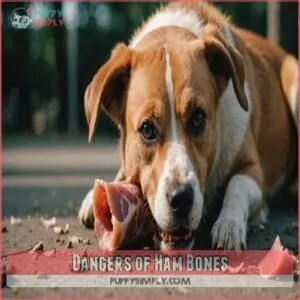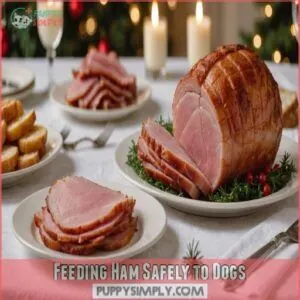This site is supported by our readers. We may earn a commission, at no cost to you, if you purchase through links.

While your pup might give you those irresistible puppy eyes when you’re slicing ham for sandwiches, this popular meat is loaded with sodium and fat that isn’t ideal for their health.
Think of ham like those tempting late-night snacks – a little nibble won’t hurt, but too much can lead to problems.
If you’re looking to treat your furry friend, consider options like cooked pork chops, which are a safe and healthy alternative as outlined in the vet-approved guide to safe pork feeding, from lean meats to specially designed dog treats.
Table Of Contents
- Key Takeaways
- What is Ham for Dogs
- Ham Risks for Dogs
- Can Dogs Eat Ham
- Ham Alternatives for Dogs
- Dangers of Ham Bones
- Feeding Ham Safely to Dogs
- Choosing The Right Food for Dogs
- Frequently Asked Questions (FAQs)
- Can dogs eat deli ham?
- Can dogs eat sweetened Ham?
- Can dogs eat smoked ham?
- Can dogs eat Heinz Ham?
- Can a dog get sick from eating ham?
- Can dogs eat cubed Ham?
- Is cooked ham ok for dogs?
- What happens if my dog ate ham?
- Why can’t dogs have ham or bacon?
- Can dogs eat honey roast ham?
- How much protein does ham provide to dogs?
- Can puppies eat ham as a treat?
- Is cooked ham better than raw ham?
- Does spiral ham affect dogs differently than regular?
- How long can ham stay in dogs stomach?
- Conclusion
Key Takeaways
- You can give your dog small amounts of ham as an occasional treat, but it shouldn’t make up more than 10% of their daily caloric intake.
- You’ll want to avoid ham bones completely, as they can splinter and cause choking or intestinal blockages that may require emergency veterinary care.
- Similar health concerns are seen with prosciutto, which can lead to medical conditions from high fat and sodium. You should watch for signs of ham-related health issues in your dog, including excessive thirst, vomiting, diarrhea, or lethargy—these could indicate sodium overload or pancreatitis.
- You’re better off choosing lean protein alternatives like plain chicken, turkey, or fish, which provide similar nutritional benefits without ham’s high sodium and fat content.
What is Ham for Dogs
You’ll find ham in many holiday meals, but your dog’s curious glances at your plate don’t mean it’s safe for them to eat.
While ham offers some protein and B-vitamins that can benefit your pup, it’s packed with sodium and fat that might cause more harm than good.
Ham Nutritional Value
While ham might seem like a tasty treat for your four-legged friend, it’s important to understand its nutritional makeup.
You can find a wide range of products designed to help keep your dog safe around ham, such as dog ham safety products, at various online retailers.
Ham contains several essential nutrients that can be part of a balanced diet when fed properly. Here’s what you’ll find in a typical serving of ham:
- Proteins and amino acids (18-20% by weight) that support muscle development and repair
- Healthy fats (10-15% by weight), primarily monounsaturated fats that provide energy
- Essential minerals and vitamins, including iron, zinc, phosphorus, and B-vitamins for overall health
Just remember that ham’s nutritional benefits come with some considerations, which we’ll explore in detail next.
Dangers of Ham
Despite ham’s nutritional benefits, it poses several risks for your furry friend.
The high sodium content can lead to dehydration and strain your dog’s kidneys, while excessive fat might trigger pancreatitis – trust me, that’s not a vet bill you want to see.
Additionally, it’s important to remember that certain types of ham, such as those containing preservatives like nitrates, should be avoided altogether.
Some pups may develop allergies to pork, showing symptoms like itching or digestive upset.
There’s also the sneaky threat of bacteria and parasites in undercooked ham. It’s like food roulette with your pet’s health.
Even preserved ham isn’t safer, as those added chemicals and preservatives can upset your dog’s stomach.
Ham Risks for Dogs
While your dog might give you those irresistible puppy eyes at the holiday table, you’ll want to think twice before sharing that honey-glazed ham.
You’re looking at three main risks when feeding ham to your dog:
high sodium that can lead to dehydration,
excess fat that may trigger pancreatitis,
and preservatives that could upset their stomach.
High Sodium Content
Your pup’s health depends on managing sodium intake.
Feeding ham regularly can expose your dog to dangerous levels of salt, leading to severe dehydration and increased water consumption.
This excess sodium puts stress on your dog’s kidneys and can trigger hypertension.
Just like humans watching their salt intake, dogs need moderation – and ham’s high sodium content makes it a risky choice.
High Fat Content
The high-fat feast in ham can turn your pup’s tummy into a trouble zone. Even a small portion packs enough calories to contribute to weight gain and potentially trigger pancreatitis, a painful inflammation of the pancreas that might land your furry friend at the vet’s office.
- Just one ounce of ham contains up to 4 grams of fat
- Regular ham treats can lead to obesity
- Fatty foods increase the risk of heart problems
Preservatives and Additives
Processed ham often contains additives and preservatives that can upset your dog’s stomach.
Sodium nitrite, used to prevent bacterial growth and add color, may cause digestive issues.
Watch out for artificial sweeteners, especially xylitol, which is toxic to dogs.
Before sharing ham with your pup, check the ingredient list carefully – many seasonings and preservatives in holiday hams aren’t dog-friendly.
Can Dogs Eat Ham
You can feed your dog small amounts of ham as an occasional treat, but you’ll need to choose lean cuts and limit portions due to its high sodium and fat content.
If you’re planning to share holiday ham with your furry friend, make sure it’s plain, thoroughly cooked, and free from glazes or seasonings that could upset their stomach.
Lean Cuts and Low Sodium
While protecting your pup from harmful foods matters, choosing lean, low-sodium ham can make it an occasional safe treat.
Consider these key points when selecting ham for your furry friend:
- Pick cuts with visible lean meat and minimal fat marbling
- Look for low-sodium or no-salt-added varieties
- Avoid honey-glazed or sugar-coated options
- Skip processed deli ham with preservatives
Remember, even lean ham should be an occasional treat, not a regular meal component.
Cooking and Preparation
Proper ham preparation plays a vital role in ensuring your dog’s safety.
Always remove bones, trim excess fat, and cook thoroughly to kill harmful bacteria.
Here’s a quick guide to help you prepare ham safely:
| Method | Temperature | Time |
|---|---|---|
| Baking | 165°F | 20-30 min |
| Boiling | Rolling boil | 15-20 min |
| Grilling | Medium heat | 10-15 min |
| Steaming | High steam | 15-20 min |
| Microwaving | Not recommended | N/A |
Feeding in Moderation
Three key rules guide ham portions for your pup: treats should make up no more than 10% of their daily calories.
Here’s what you need to know about serving ham to your dog:
- Start with tiny pieces, about the size of a training treat
- Limit ham to once or twice per week max
- Watch for signs of stomach upset or changes in energy
Remember: moderation is key when it comes to treats!
Ham Alternatives for Dogs
If you’re looking to swap out ham for healthier options in your dog’s diet, you’ll find plenty of tasty alternatives that won’t put their health at risk.
You can treat your furry friend to lean proteins like cooked turkey, eggs, or fish that provide excellent nutrition without the high sodium and fat content of ham.
Lean Proteins and Healthy Treats
Looking for healthier options than ham?
Your pup will wag their tail for lean proteins like chicken, turkey, or salmon.
These alternatives pack the protein punch without the sodium overload.
You can also mix in some plain yogurt for added nutrition and digestive benefits.
When choosing treats, stick to single-ingredient options that you’d feel good about eating yourself – think simple and wholesome.
Safe Foods for Dogs
Choosing safe, dog-friendly foods doesn’t have to be complicated.
Instead of ham, try lean proteins like cooked chicken breast, turkey, or fish.
Many dogs love fresh vegetables such as carrots, green beans, and sweet potatoes.
You can also offer plain, low-fat yogurt or cottage cheese if your pup isn’t lactose intolerant.
Remember to introduce new foods gradually and watch for any allergic reactions.
Nutritional Value of Alternatives
Instead of ham, your pup can enjoy plenty of nutritious alternatives that pack a healthy punch.
Here are some protein-rich options that’ll make your dog’s tail wag:
When looking for a tasty treat, consider opting for turkey ham alternatives, which are lower in fat and higher in protein than regular ham.
- Lean chicken breast (26g protein per 100g)
- Turkey meat (29g protein per 100g)
- Plain Greek yogurt (10g protein per 100g)
- Cooked salmon (25g protein per 100g)
These alternatives offer better nutrition without the risks that come with ham.
Dangers of Ham Bones
You might think those leftover ham bones would make a perfect treat for your dog, but they’re actually one of the riskiest foods you can offer.
The bones can splinter into sharp pieces as your dog chews, creating dangerous hazards that can lead to choking or cause serious damage to their digestive system.
Splintering Risk and Choking Hazard
Many dog owners don’t realize that ham bones pose serious splintering risks and choking hazards for their furry friends.
According to experts, ham bones can even cause internal injuries like esophageal damage, intestinal blockages, rectal perforation, and internal bleeding, as explained in the guide on risks of ham bones.
Here’s what you need to know about bone safety:
| Risk Level | Bone Type | Safety Concerns |
|---|---|---|
| High | Cooked Ham | Splinters easily |
| Medium | Smoked Ham | Brittle texture |
| Low | Fresh Ham | Still not safe |
When cooked, ham bones become brittle and can splinter into sharp pieces that might lodge in your dog’s throat.
They’re especially dangerous during the holidays when you’re busy entertaining and mightn’t notice your pup sneaking a bone from the trash. It’s better to stick with vet-approved chew toys.
Intestinal Blockage and Obstruction
Beyond the risks of splintering, ham bones can create serious intestinal blockages in your dog.
When swallowed, bone fragments don’t always pass through smoothly.
You’ll want to watch for these warning signs that could spell trouble:
- Your pup’s straining but can’t poop
- Their belly feels hard or swollen
- They’re refusing food but drinking lots of water
- Vomiting or dry heaving becomes frequent
- They seem unusually lethargic or uncomfortable
If you notice any of these signs, don’t wait it out – contact your vet right away.
Intestinal blockages can become life-threatening quickly, and they often require immediate medical attention to resolve.
Feeding Ham Safely to Dogs
If you’re going to share ham with your dog, you’ll need to follow some essential safety guidelines to protect their health.
While most dogs can handle small amounts of properly prepared ham as an occasional treat, you’ll want to monitor their portion sizes and stick to lean, low-sodium cuts.
Moderation and Balance
How much ham can you safely feed your dog, considering the importance of portion control for high-fat content?
Think of ham like a special treat – not an everyday meal.
When serving ham to your pup, keep portions small (about the size of a dice) and limit it to occasional treats.
Balance is key – ham should make up no more than 10% of your dog’s daily diet, with the rest coming from regular dog food.
Avoiding Ham for Certain Conditions
Your dog’s health conditions play a big role in whether ham should be off the menu completely.
If your furry friend has kidney disease, you’ll want to skip the salty meat altogether.
Dogs with allergies to pork, a history of pancreatitis, or ongoing digestive issues should also avoid ham, and if you suspect a ham allergy, you can find products for dog ham allergies online at dog ham allergy.
For pups watching their weight, ham’s high fat content makes it a no-go.
Monitoring Your Dog’s Health
When feeding ham to your pup, keep a watchful eye on these key health indicators:
- Monitor their weight closely, as even small amounts of ham can pack extra calories
- Watch for excessive thirst or changes in urination, which might signal sodium issues
- Check their energy levels during walks and playtime
- Look out for digestive changes like loose stools or occasional vomiting, which could mean ham doesn’t agree with them
Choosing The Right Food for Dogs
You’ll find that choosing the right food for your dog isn’t as complicated as those endless aisles of pet food might suggest.
Whether you opt for dry kibble, wet food, or a mix of both, what matters most is picking a complete and balanced diet that matches your pup’s age, size, and activity level.
Complete and Balanced Dog Food
Choosing balanced dog food doesn’t have to be complicated.
Here’s a quick guide to picking the right food that’ll keep your pup’s tail wagging:
| Nutrient Type | What to Look For |
|---|---|
| Proteins | Named meat sources (chicken, beef) |
| Fats | Omega-3 and omega-6 fatty acids |
| Carbohydrates | Whole grains, sweet potatoes |
| Vitamins | A, D, E, B-complex listed |
| Minerals | Calcium, phosphorus, zinc |
Look for foods with AAFCO certification on the label – it’s like a seal of approval that tells you the food meets nutritional standards.
Skip anything with artificial preservatives or generic meat by-products.
Remember, what works for one dog mightn’t work for another, so you might need to try different options.
Wet and Dry Food Options
Both wet and dry food offer unique benefits for your dog.
Dry kibble lasts longer and helps maintain dental health, while wet food’s higher moisture content can keep your pup hydrated.
You’ll find dry food’s typically more budget-friendly, but some dogs prefer wet food’s richer taste and texture.
If you’re torn between the two, try mixing them – many pet parents combine a scoop of wet food with kibble to create a tasty, balanced meal.
Just remember to adjust portions accordingly, and watch for any food sensitivities.
You can even alternate between wet and dry food on different days.
Frequently Asked Questions (FAQs)
Can dogs eat deli ham?
Deli ham isn’t your dog’s best friend.
While small amounts won’t hurt most pups, its high sodium and fat content can lead to health issues.
You’re better off sticking to regular dog food and treats.
Can dogs eat sweetened Ham?
No, you shouldn’t feed your dog sweetened ham.
It’s dangerous due to high sugar content on top of ham’s already high sodium levels.
This combination can lead to serious health issues including diabetes and dehydration.
Can dogs eat smoked ham?
While 73% of pet owners share table scraps, you shouldn’t feed your dog smoked ham.
It’s packed with excessive sodium and preservatives that can harm your pup’s health.
Stick to regular dog food instead.
Can dogs eat Heinz Ham?
Feeding your dog Heinz Ham isn’t recommended due to its high sodium and preservative content.
If you’re considering giving your dog ham or other cooked meats, remember that even cooking spoiled meat doesn’t eliminate all risks, such as bacterial loads from spoiled meat. If you’d like to treat your pup, stick to plain, unseasoned cooked meat or specially made dog treats instead.
Can a dog get sick from eating ham?
Your dog can definitely get sick from eating ham since it’s packed with sodium and fat.
Watch out for signs like vomiting, diarrhea, excessive thirst, and potential pancreatitis, especially after eating large amounts.
Can dogs eat cubed Ham?
Dogs shouldn’t eat cubed ham regularly due to its high salt and fat content.
It’s best to limit it to tiny, occasional treats.
Fresh, lean meat options are much safer for your pup.
Is cooked ham ok for dogs?
Like Lisa’s pup who got sick from holiday ham, cooked ham isn’t ideal for dogs.
While it’s not toxic, the high sodium and fat content can cause dehydration and upset stomachs.
It’s best avoided.
What happens if my dog ate ham?
Occasional small bites of ham shouldn’t cause issues, but watch for vomiting, diarrhea, or excessive thirst due to high sodium.
If these symptoms persist or your pup seems lethargic, call your vet.
Why can’t dogs have ham or bacon?
Your pup’s health matters, and that’s why ham and bacon aren’t good choices.
They’re packed with too much salt and fat, which can lead to serious health issues like pancreatitis and dehydration.
Can dogs eat honey roast ham?
Honey roast ham isn’t safe for dogs.
It’s packed with excess sodium, sugar, and preservatives that can cause dehydration and digestive issues.
Skip the holiday ham and stick to plain, lean meats instead.
How much protein does ham provide to dogs?
Like a meaty treasure for dogs, ham offers about 18-20% protein by weight.
While it’s a protein-rich food, you’ll want to limit portions due to its high sodium and fat content.
Can puppies eat ham as a treat?
While puppies can technically eat ham, it’s not recommended as a treat.
The high sodium and fat content could upset their developing digestive system.
Stick to puppy-specific treats designed for their nutritional needs.
Is cooked ham better than raw ham?
According to experts, bacteria can multiply 10x faster in raw ham.
You’ll want to serve your dog thoroughly cooked ham, heated to 165°F, which kills harmful bacteria and makes it safer to digest.
Does spiral ham affect dogs differently than regular?
Spiral ham is even riskier for dogs than regular ham due to its higher sodium and fat content.
You’ll want to avoid feeding it to your pup entirely to prevent potential health issues.
How long can ham stay in dogs stomach?
Ham typically stays in your dog’s stomach for 4-8 hours during digestion, but watch for signs of discomfort. If you notice vomiting or lethargy after 12 hours, call your vet immediately.
Conclusion
Like a smartphone without a charger, dogs need the right fuel to function at their best.
While you might be tempted to share your holiday ham, remember that moderation is key.
You can feed your dog small amounts of lean, unseasoned ham as an occasional treat, but it shouldn’t become a regular habit.
If you’re wondering "can dogs eat ham" regularly, the answer is no – stick to specially formulated dog food and healthier treats to keep your furry friend happy and healthy.

















